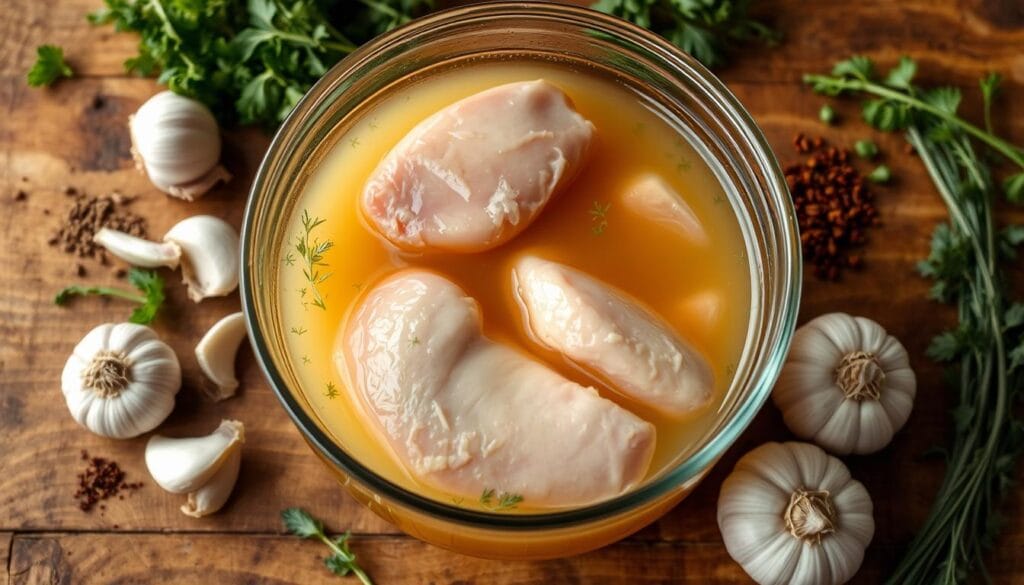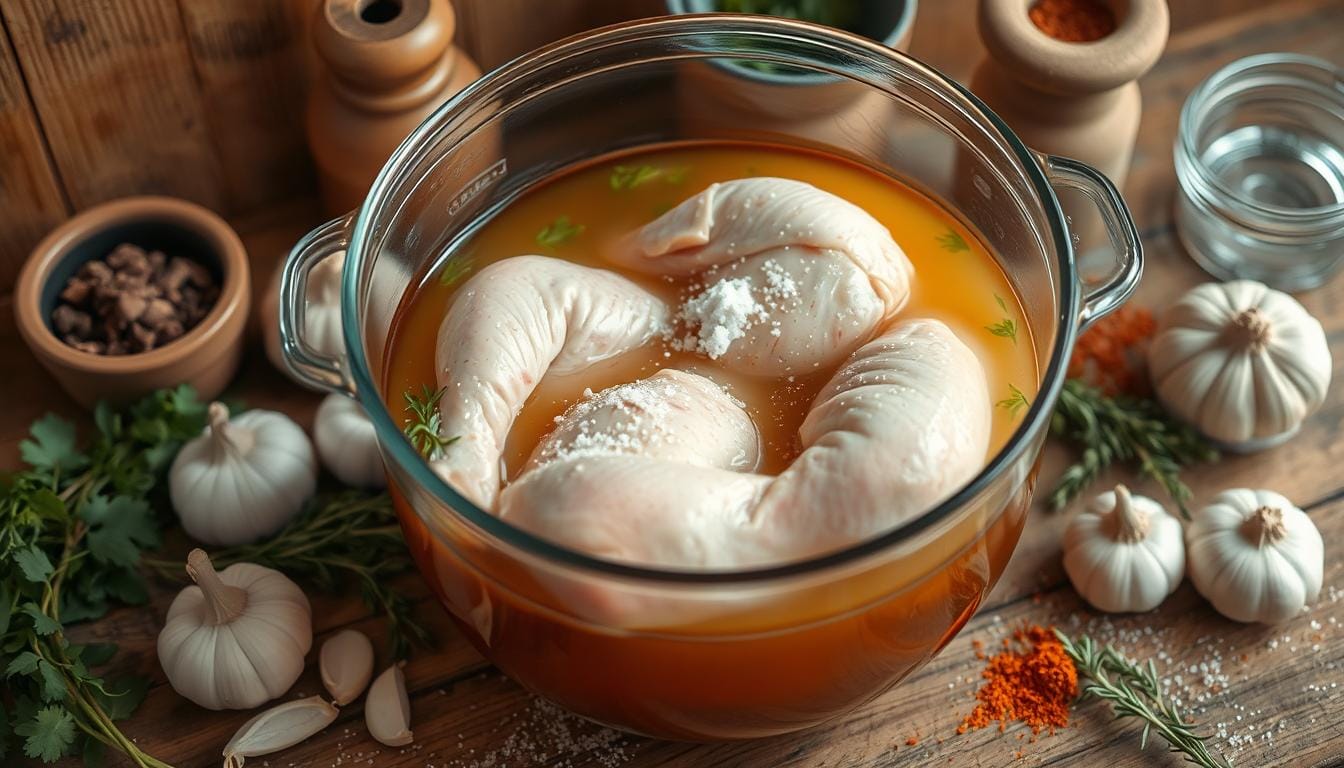How to Brine Chicken for Perfectly Juicy Results
As a seasoned home cook, I’ve always sought the perfect chicken. It’s the kind that’s full of juices and flavor, making every bite a joy. I found the secret to perfect chicken in brining.
Brining might seem hard, but it’s a game-changer. It makes your chicken dishes better. In this guide, we’ll explore brining’s science, the best brine ingredients, and how to brine chicken perfectly.
Table of Contents
Understanding the Science Behind Chicken Brining
Brining chicken is a time-honored technique that makes ordinary poultry juicy and flavorful. But have you ever wondered what’s happening beneath the surface? Let’s dive into the science behind this culinary magic.
Osmosis and Salt Penetration Process
The key to brining’s success lies in the principles of osmosis. When you submerge chicken in a brining chicken solution, the salt molecules start to penetrate the meat. This process draws moisture into the muscle fibers, making the chicken more tender and juicy.
Chemical Changes in Meat Fibers
But brining does more than just add moisture. The salt also triggers chemical changes in the chicken’s protein structures. It breaks down the muscle fibers, making them more pliable and easier to chew. This transformation is what gives brined chicken its signature melt-in-your-mouth quality.
Moisture Retention Mechanics
As the chicken brine solution saturates the meat, it creates a semi-permeable barrier. This barrier traps moisture within the chicken during cooking. This moisture retention is what prevents the poultry from drying out, even when exposed to high heat. The result is a succulent, juicy bird that’s bursting with flavor in every bite.
By understanding the science behind brining, you can unlock the full potential of your chicken dishes. Create restaurant-worthy meals right in your own kitchen. Embrace the power of osmosis and unlock the secrets to perfectly juicy, flavorful poultry every time.
Essential Ingredients for the Perfect Chicken Brine
Making the perfect chicken brine recipe is all about mixing the right ingredients. These ingredients turn regular brined chicken meat into something truly delicious. Let’s dive into what makes this magic happen.
Salt is at the core of a great chicken brine. It boosts the flavor and is key to the brining process. Salt pulls moisture into the chicken, making it juicier and tenderer.
- Choose high-quality, unrefined salt like Kosher or sea salt for the best taste.
- The salt-to-water ratio is usually 1/4 cup of salt per 1 quart of water. But you can adjust it to your liking.
Sugar is another must-have, and it can be white granulated, brown sugar, or honey. It adds sweetness to balance out the saltiness, creating a rich flavor.
| Ingredient | Purpose |
|---|---|
| Salt | Enhances flavor and facilitates the brining process |
| Sugar | Balances the saltiness and adds depth of flavor |
| Water | Provides the medium for the brine solution |
| Aromatics (optional) | Infuses the chicken with additional flavors, such as herbs, spices, or citrus |
Adding aromatic ingredients like herbs, spices, or citrus can make the brine even better. Try different mixes to find your favorite taste.
“Brining is the secret to juicy, flavorful chicken every time. The right combination of salt, sugar, and aromatics transform the most basic chicken dish into a culinary masterpiece.”
Basic Chicken Brine Recipe and Ratios
Making the perfect chicken brine is about finding the right mix of ingredients. The salt-to-water ratio is key for that juicy, flavorful chicken.
Salt-to-Water Proportions
For a basic chicken brine, use 1/4 cup of kosher salt for every 4 cups of water. This 1:16 ratio helps the brine soak into the meat. It keeps the chicken moist and full of flavor.
Additional Seasonings and Aromatics
While the salt-to-water ratio is the base, you can add more flavor. Try fresh herbs like rosemary, thyme, or sage. Or, use citrus peels like lemon or orange. Spices like peppercorns, bay leaves, or brown sugar can also enhance the taste.
Temperature Considerations
The brine’s temperature is important. Brine your chicken in a cool, refrigerated spot, between 35°F and 40°F. This keeps the meat safe and the brine effective.
Follow these tips, and you’ll get juicy, flavorful chicken every time.
How to Brine Chicken: Step-by-Step Guide
Brining your chicken makes it moist, flavorful, and perfectly cooked. Follow this easy guide to master brining chicken and improve your cooking.
- Prepare the Brine Solution: Mix salt and water in a large pot or container. Add seasonings or aromatics if you like. Stir until the salt dissolves.
- Submerge the Chicken: Carefully put the chicken pieces or whole bird in the brine. Make sure they’re fully covered. Then, cover the container and refrigerate.
- Brine for the Optimal Time: The brining time varies by chicken cut. Plan for 30 minutes to 2 hours for smaller pieces. For a whole chicken, brine for up to 24 hours.
- Rinse and Pat Dry: After brining, take the chicken out and rinse it under cold water. Pat it dry with paper towels.
- Cook the Brined Chicken: Now, your chicken is ready to cook. Use roasting, grilling, or sautéing. Enjoy the juicy, flavorful chicken from your brining chicken efforts!
Learning brining chicken techniques takes practice, but it’s worth it. With this guide, you’ll get perfectly brined chicken every time.

“Brining is a game-changer for chicken, transforming even the most basic bird into a juicy, flavorful delight.”
Optimal Brining Times for Different Cuts
Brining makes chicken juicy and flavorful. But, the right brining time changes with the chicken cut. Let’s explore the best brining times for each part.
Whole Chicken Brining Duration
For a whole chicken, brine it for 12-24 hours. This long soak time ensures the brine reaches the bird’s thick parts. It keeps the chicken moist and evenly seasoned.
Breast and Thigh Portions
Chicken breasts and thighs need less brining time. They should soak for 4-8 hours. Brining chicken breasts too long can make them mushy.
Wings and Small Pieces
Wings and drumsticks need the least brining time. They should soak for 2-4 hours. These thin cuts absorb brine fast, so don’t overdo it.
The chicken brine time is key for great taste and juiciness. Adjust the brining time for each chicken cut to get the best results.
Common Brining Mistakes to Avoid
Brining your chicken can make a huge difference. It turns dry meat into juicy, flavorful food. But, doing it wrong can lead to bad results. Learn these chicken brining tips and brining chicken techniques to make your chicken amazing.
- Over-Brining: Longer soaking times can make meat juicier and tastier. But, too long can make it too salty. Watch the brining time for different cuts and sizes.
- Using the Wrong Salt: Not all salts are good for brining. Use kosher or sea salt. Avoid iodized table salt, as it tastes bad.
- Improper Temperature Control: Brining must be in the fridge to avoid bacteria. Don’t leave your chicken at room temperature.
| Brining Mistake | Impact on Chicken | How to Avoid |
|---|---|---|
| Over-Brining | Overly salty, unpalatable texture | Follow recommended brining times |
| Using Incorrect Salt | Metallic, off-putting flavor | Opt for kosher or sea salt |
| Improper Temperature | Bacterial growth, food safety issues | Brine in the refrigerator |
Avoid these common chicken brining tips and brining chicken techniques. You’ll get perfectly juicy and flavorful chicken every time.

Flavored Brine Variations and Recipes
Make your brined chicken dishes even better by trying out different brine flavors. You can add herbs, citrus, or sweet elements to change the taste. This way, you can make your brined chicken just how you like it.
Herb-Infused Brines
Give your chicken brine recipe a fresh twist with herbs. Mix thyme, rosemary, and sage for a rich, earthy flavor. Or, try cilantro, parsley, and oregano for a bright, herbal taste.
Citrus and Sweet Brines
Add a tangy twist to your brined chicken meat with citrus. Use lemon, orange, or grapefruit zest and juice for a zesty kick. Mix it with honey or maple syrup for a sweet and sour mix.
Spicy Brine Options
Spice up your chicken with a fiery brine. Use crushed red pepper flakes, sliced jalapeños, or hot sauce for heat. Add garlic, cumin, or smoked paprika for a full flavor.
Try these brine variations to find your favorite brined chicken meat recipe. The world of flavors is vast, so feel free to experiment and find what you love.
Cooking Methods for Brined Chicken
Now that your chicken is brined, it’s time to cook it. Roasting is a great choice because it keeps the meat juicy. Season the chicken with your favorite herbs and spices, then roast at a high temperature until it reaches 165°F.
Grilling the chicken is also a good option. The brine helps it stay moist, so you get a juicy inside and a crispy outside. Just grill at a slightly lower temperature to prevent drying out.
For crispy fried chicken, brining is key. It makes the meat juicy and flavorful. Pat the chicken dry before frying to get that perfect crispy crust.

